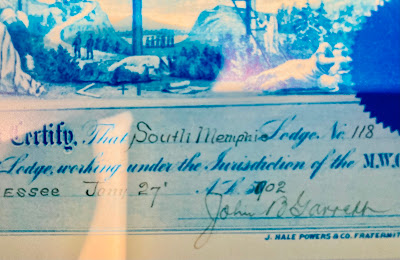First in a series recapping my recent trip to New Orleans.
Speaking of the Civil War (see post below)…
While it is among the smaller museums in a historic city that offers countless places to visit, Louisiana’s Civil War Museum at Confederate Memorial Hall in New Orleans houses the second largest collection of Confederate items in the world. Established in 1891, it is Louisiana’s oldest museum and it is filled with artifacts donated by men who fought in the War Between the States, and the families who survived them.
And there are several items of Masonic interest.
One enters the cathedral-like Romanesque entrance of the sandstone structure and beholds a gorgeous space crafted of Louisiana cypress with meticulously arranged exhibits. Not a cubic inch is fallow, as the walls display battle-torn flags, and numerous display cases exhibit uniforms, an arsenal of firearms and bladed weapons, and personal items of legendary leaders and regular soldiers alike.
There is a helpful staff who can field most questions, but a visitor is free to enjoy a self-guided walk around. It is recommended that one begin with an introductory video that is screened in a small room off the main hall. It was there where I encountered the first Masonic reference.
The short video tells the story of the museum’s origins, including how some of the first artifacts came into its possession.
Part of the narrative involves a letter and a box of personal effects sent in 1867 to the mother of a slain Confederate officer.
Eliza Crosby Field, of Mansfield, Louisiana, wrote to the late Lt. Charles Horton’s mother in New Orleans. Excerpted:
Dear Mrs. Horton,
 |
| Charles Horton |
I send by my Uncle, Mr. E.H. Crosby, a box Lt. Horton used during the war. I thought you would like it simply because it belonged to your dear son, and also as a relic of Confederate times. I think such things are heirlooms in a family that should be transmitted from one generation to another through all coming time. There were so few things I had to pack, put straw in with them. In a little book, the Masonic Manual, you will find a lock of his hair which I know from experience you will prize above all things.
That parcel contained insignia off Horton’s uniform, remnants of the Confederate flag and regimental colors he was believed to have held aloft when he was cut down in the Battle of Mansfield on April 8, 1864, and other militaria and personal items. Many of these pieces are displayed inside a glass case, with his uniforms, sword, and the above photo of Horton, in the screening room.
The Masonic Manual is not among them, unfortunately, so we cannot see any possible inscription therein that may have identified Horton’s lodge or other clues.
I believe the Masonic Manual most likely was that published by Robert Macoy, a pocket-sized monitorial book of exoteric parts of our degrees and other useful literature. There were several editions of that during the 1850s and ’60s, the first, I think, in 1852.
 |
hanna1172 1861 edition available now on eBay. |
Earlier this year, Macoy Masonic Supply Co. in Virginia published a painstaking reprint of the 1867 edition. Not merely a facsimile reproduction, but an actual reprinting in a limited edition, handmade on their 1850s letterpress, employing the original hand-carved wooden dies for the illustrations. (A Magpie review is forthcoming.)
There were other Masonic monitors in that period, but Macoy’s showed the title Masonic Manual boldly across the front cover.
Among the items of more prominent Confederate warriors is a collection that had belonged to Gen. Braxton Bragg. The namesake of Fort Bragg (now Fort Liberty) is not remembered kindly by history, as he is blamed for repeated defeats during the Civil War and had earned a reputation for disharmony among the officer corps throughout his career in the American and Confederate armies. He was even court-martialed in 1844, but received easy punishment.
 |
| Gen. Braxton Bragg display. |
This museum exhibits an assortment of Bragg’s belongings, all attractively presented behind glass: a dress uniform frock coat; his sword, scabbard, and sword belt; a telescope; his Bible; a toothpick; and more. That sword and, oddly enough, the toothpick are the Masonic pieces.
 |
| Click here to see Winfield S. Hancock’s sword. |
Within the decorative metalwork that fills the weapon’s guard, the Square and Compasses are visible. I wouldn’t say prominently—you really have to look at it—but the initiated eye can discern it easily enough.
 |
| Gen. Braxton Bragg’s toothpick. |
The toothpick may be made of ivory and is in the shape of a pistol. Plainly seen on the “grip” of the pistol is the Square and Compasses in red. (Maybe there’s a bone box joke somewhere in there!)
The potential for more Masonic content in Louisiana’s Civil War Museum at Confederate Memorial Hall is great, especially when considering Freemasonry’s history and diversity in the Pelican State, but the truth is this museum originated as a meeting place for Civil War veterans, so it is not a large place. (The nearby National WWII Museum spans 33,000 square feet in comparison.) But Freemasons who cherish the study of the Civil War, especially from the Southern point of view, will love this museum regardless of any alleged paucity of Masonic memorabilia.
It is located at 929 Camp Street in New Orleans. Click here for more information and beautiful photos.















































































